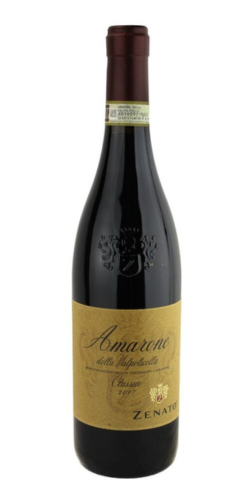
Our Rating

Veneto
Corvina
This critic favorite has everything you want from an Amarone: drinkability, complex dark fruit, and a long, balanced finish.
In 1960, near the banks of Italy’s largest lake, Lake Garda, Sergio Zenato got his start in the wine business.
Lake Garda, or, more specifically, Italy’s Lugana region, is known for its white wines made with Turbiana grapes. Turbiana grapes, which the locals call ‘Trebbiano di Lugana,’ produce dry white wines that are known for their acidity. The wines are a specialty of Lugana.
As Sergio established himself as a talented maker of these local white wines, his vision for the future grew. It didn’t take long for him to set his sights on nearby Valpolicella, one of Italy’s most prized areas of wine production.
Sergio invested in native grape varieties like Corvina and Rondinella, and the brand’s red wine portfolio was born.
Zenato operates three estates. S. Cristina Estate produces Zenato’s foundational white wines, which include a single vineyard Trebbiano di Lugana, and two sparkling variations. Costalunga Estate is devoted to Amarone, and a micro-estate of just under 4 hectares is home to Zenato Wines Bolgheri DOC efforts that are crafted from French varieties Cabernet Sauvignon and Merlot. In total, Zenato has an impressive 95 hectares under vine.
Zenato patriarch Sergio has since passed, but his winery lives on under the careful management of his children, Nadia and Alberto. Nadia manages the brand’s marketing, and Alberto oversees the winemaking.
Sergio’s children have taken his vision, carried it into the future, and even expanded on the family’s legacy by creating the Zenato Academy. The Zenato Academy acts as a laboratory to support young artists as they explore the intersections of wine, culture, and photography.
Amarone wine, or Amarone della Valpolicella, the wine’s formal name, is a style of red wine that hails from Italy’s Valpolicella region in Veneto. Amarone undergoes a unique winemaking process. Unlike other red wines, which follow the traditional process of harvest, crush, macerate, and ferment, the grapes used in Amarone are first air-dried at harvest, sort of like raisins. Depending on the producer, the grapes are dried for as little as 60 days or up to 120 days. The minimum length of time for a wine to be designated as Amarone wine is 60 days.
Drying the grapes, rather than immediately crushing them, concentrates the fruits’ sugars. Because there is more sugar present during fermentation, there is more “food” for the yeasts, which creates those high alcohol levels that Amarone is known for. The fermentation process reduces the sweetness in the juice so that what’s left is a dry red wine with what is typically considered a very high amount of alcohol.
The grapes in this bottle were dried for between three to four months, and the alcohol level is 16.5%.
As noted above, Amarone wines are a style of wine rather than a grape variety. The wine is made using grapes native to Veneto, including Corvina (the most common), Corvinone, Rondinella, Molinara, Croatia, and Oseleta. Amarone wines can contain up to 80% Corvina grapes. The grapes in the 2017 Zenato Amarone breakdown into 80% Corvina, 10% Rondinella, 5% Croatina, and 5% Oseleta.
The 2017 Zenato Amarone Della Valpolicella Classico Corvina is a deep garnet color in the glass with day-bright clarity.
Typical of a well-crafted Amarone, the nose is a bouquet of dried leather, sweet plum, and fig, and concentrated black currant. The aromas are intense but lightly perfumed and pleasant.
A velvety soft palate with concentrated notes of ripe black cherry, blackberry, and plum dance with rich fig and prune and old saddle leather. This is a luxurious wine with memorable qualities and pronounced flavors that aren’t shy about expressing themselves. For a wine this powerful, you might expect the alcohol and the robust palate to overwhelm the finish, but instead, what you get is very much in balance with the rest of the wine.
Amarone wine is known for its ageability, so you could conceivably hold onto this wine for another five to ten years before drinking. Pair it with a hand-cut steak or a salumi plate for an exceptional evening of food and wine.
Italy
Veneto
Corvina
16.5
Alberto Zenato
30 to 60 Minutes
Now to 2027
Zenato


All things wine, and food you could ever need or want — straight to your email!